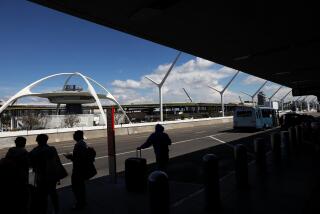John Wayne Airport to Get Microwave Landing System
- Share via
The Federal Aviation Administration plans to install a state-of-the-art microwave landing system to guide aircraft into John Wayne Airport by February, 1989, FAA and airport officials said Wednesday.
The airport is on a list of more than 170 facilities nationwide scheduled to receive microwave landing systems during the next two years, officials said.
However, John Wayne Airport Manager George A. Rebella said Wednesday that he intends to talk to airlines and their top pilots about raising money to install the technologically advanced system as soon as possible. He said Sun Valley, Ida., recently installed such a system instead of waiting for the FAA. Also, both the FAA and Rebella said Wednesday that the 1989 installation date at John Wayne is based on optimistic scheduling; the national installation program is already a year behind schedule.
Ground-based transmitters for microwave systems cost about $800,000, and receiving equipment costs $15,000 to $25,000 per aircraft. The systems improve air safety because they are more accurate than current instrument-landing equipment, officials said.
Landings in Zero Visibility
Microwave systems allow pilots to land in extreme weather, with zero visibility, and they handle so-called “autoland” approaches, in which control of a landing aircraft passes from the pilot to a computer that actually takes the aircraft to touchdown on the runway.
At most airports, including John Wayne, instrument-landing procedures still require pilots to abandon their approaches at altitudes of 200 feet or higher if, at that level, they cannot see the runway.
New Planes Already Equipped
Many aircraft owners say they cannot afford the costly microwave receiving gear that must be on each plane that uses microwave landing systems. However, several airlines have ordered new jetliners that come factory-equipped with microwave gear, which eases and speeds air controllers’ handling of aircraft, according to the FAA, thus reducing flight delays at crowded airports.
Although John Wayne Airport does not frequently experience bad weather, having the new system would help alleviate a problem caused by the recent shutdown of a radio beacon that had been transmitting weather and airport-location information to pilots landing under visual flight rules instead of using the airport’s radar-guided, instrument-landing approach.
Building Deflected Signals
Microwave systems are affected less adversely than radar by local terrain, including tall buildings, according to the FAA.
The beacon used by pilots flying under visual flight rules was turned off earlier this year after FAA tests confirmed that a new Hutton Centre building in Santa Ana was deflecting its signals. Relocating the cone-shaped device last month from the airport grounds to the top of a nearby building failed to solve the problem.
The FAA has been studying use of a less sophisticated beacon for pilots approaching the airport under visual flight rules and may approve it in the next few weeks, officials said.
Meanwhile, Rebella said a consultant may be hired soon to evaluate the FAA’s scientific data on the signal interference caused by the Hutton Centre building as part of the county’s effort to see if a lawsuit to collect damages should be filed against Hutton Centre and the City of Santa Ana.
The developer and city officials allegedly ignored warnings that the Hutton Centre tower was going to be hazardous to airport navigation. Hutton Centre and the city say the FAA never made specific findings or issued any orders that might have prohibited construction.
More to Read
Inside the business of entertainment
The Wide Shot brings you news, analysis and insights on everything from streaming wars to production — and what it all means for the future.
You may occasionally receive promotional content from the Los Angeles Times.










